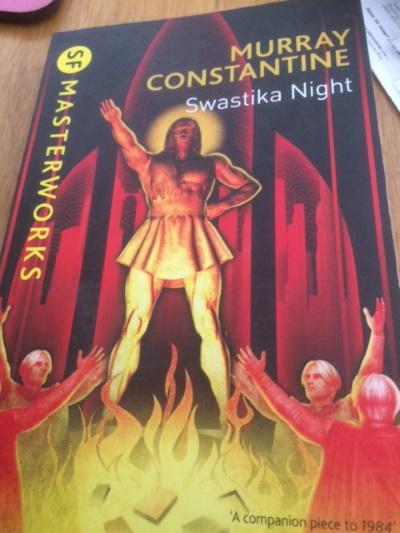Book Review by Kathryn R: This novel set some 700 years in the future is by Katherine Burdekin, writing under a pseudonym. Katherine Burdekin wrote feminist dystopian fiction in the 1920 both under her own name and the pseudonym. She also wrote some children’s fiction.
 Cover of 21016 reprint by Victor Gollancz
Cover of 21016 reprint by Victor Gollancz
The novel describes a world ruled by two superpowers, the Germans and the Japanese. The people of the Holy German Empire venerate Hitler as a god. Statues of him exist in every town, where he is depicted as a very tall blond-haired muscular powerful figure. Holy Hitler chapels, shaped like swastikas, are used for worship of Hitler. All services start with a recitation of the Creed, which begins:
‘I believe in God the Thunderer, who made this physical world on which men march in their mortal bodies, and in His Heaven where all heroes are, and his son Adolf Hitler, the Only Man. Who was not begotten, not born of woman, but Exploded’.
The author describes a world where only the masculine is valued. Homosexuality is the norm because men revere the male body. Women are kept in caged villages and their sole function is to give birth to boy children. Girls stay in the cages, whilst boys are taken away to be brought up by men. The women have their heads shaved and wear gray ragged clothes to make them look sexless. At the beginning of the novel, there is some concern in parts of the empire that women have stopped giving birth to girls. Women are needed to procreate the race.
There are two classes of men – Knights, descended from Hitler’s contemporaries and Nazis. Everyone who isn’t German has little value. The Jews have been completely exterminated and Christians live outside society.
The story starts with the arrival in the village of Alfred, an Englishman on a pilgrimage of the Holy Sites which include the Holy City (Munich) the Sacred Hangar and the Sacred Aeroplane. Alfred renews his acquaintance with Hermann, a Nazi who has previously spent his military service in England.
Hermann is in the service of Knight von Hess, supposedly a descendant of Rudolf Hess. This family connection turns out to be false – like a number of the myths abounding in the Holy German Empire.
Knight von Hess is nearing the end of his life and has no sons. He decides to entrust Alfred and Hermann with a book which has been handed down through his family. Before showing them what the book contains he shows them a photograph of Adolf Hitler and a beautiful young person with long blond hair. They are horrified that this is what Hitler really looked like and even more horrified to learn that the other person in the photograph is a girl, not a young man. Only young men can be beautiful in the Holy German Empire. The book turns out to be a true history of the Empire. This book must be kept secret at all costs.
Alfred manages to get the book back to England and hide it in a cave under Stonehenge, a place the Germans fear.
The second half of the book is spent with Alfred and his son Fred going to the cave in the evenings and reading the book by candlelight. Eventually they are discovered by the German occupiers, but Fred manages to escape with the book and get it safely hidden with a group of Christians.
In places the book is too didactic, with details of the rationale for the behavior of the leaders of the German Empire and extracts from the history book, but the story is sufficiently engaging to keep this reader going.
I found the book interesting from a political point of view because it was written in 1937, before the start of World War Two and before the full horror of Hitler’s plan to exterminate the Jews was widely known.
It was also interesting because 80 years on, I found some scenes as shocking as readers would have done on publication, particularly the descriptions of the treatment of women.
Early in the book, the women go to their regular visit to the church and a sermon is delivered by a senior Knight
‘the most important thing was to get it firmly fixed in the heads of younger women that they must not mind being raped. Naturally the Knight did not call it this, there was no such crime as rape except with children under age. And this, the Knight knew, was less, far less for the sake of the race. Very young girls might bear puny babies as the result of rape.’
As well as the depiction of women and their role, the book shocks the reader because there is always the threat of violence hanging over everyone and every action.
I think Burdekin wrote this book as a warning of the consequences of allowing evil to go unchallenged. It was described by John Clute, a critic specialising in Science Fiction as ‘a scathing feminist anatomy of war, sexism and power’.
